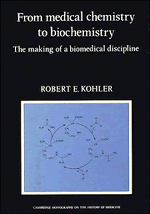Book contents
- Frontmatter
- Contents
- 1 Introduction: On discipline history
- 2 Physiological chemistry in Germany, 1840–1900
- 3 Physiology and British biochemists, 1890–1920
- 4 General biochemistry: the Cambridge school
- 5 European ideals and American realities, 1870–1900
- 6 The reform of medical education in America
- 7 From medical chemistry to biochemistry: the emergence of a discipline
- 8 Unity in diversity: the American Society of Biological Chemists
- 9 The clinical connection: biochemistry as applied science
- 10 Chemical ideals and biochemical practice
- 11 Biological programs
- 12 Epilogue: Toward a molecular biology?
- Location of archival sources and abbreviations
- Notes
- Index
9 - The clinical connection: biochemistry as applied science
Published online by Cambridge University Press: 07 October 2011
- Frontmatter
- Contents
- 1 Introduction: On discipline history
- 2 Physiological chemistry in Germany, 1840–1900
- 3 Physiology and British biochemists, 1890–1920
- 4 General biochemistry: the Cambridge school
- 5 European ideals and American realities, 1870–1900
- 6 The reform of medical education in America
- 7 From medical chemistry to biochemistry: the emergence of a discipline
- 8 Unity in diversity: the American Society of Biological Chemists
- 9 The clinical connection: biochemistry as applied science
- 10 Chemical ideals and biochemical practice
- 11 Biological programs
- 12 Epilogue: Toward a molecular biology?
- Location of archival sources and abbreviations
- Notes
- Index
Summary
The most significant pattern in the history of American biochemistry prior to 1940 is its close connection to clinical medicine. The first generation of American biochemists to acquire international reputations were known for their achievements in clinical biochemistry; for example, Otto Folin, Stanley Benedict, and D. D. Van Slyke. Most departments of biochemistry were in medical schools and their prosperity depended on their service roles in medical instruction and clinical research in hospital laboratories and research wards. Biochemists regarded clinical medicine as a crucial source of important and fundable research problems, employment for their students, and political support for their profession.
This view may appear to contradict the idea, developed in Chapter 7, that biological chemists liberated themselves from clinical medicine in the period of reform. The drama of succession should not distract us from the underlying continuity. Biochemists freed themselves from a particular kind of relationship only to reestablish the relationship on a new basis. What had been either a hybrid or dependent role became a more or less equal partnership. In the process, clinicians as well as biochemists were obliged to adapt their disciplinary ideals.
As long as there was little opportunity for medical chemists to build a specialized discipline, there was no great problem of reconciling divergent disciplinary goals. Many of the old medical chemists were clinicians, so no role conflict existed there. The rest were applied chemists, who practiced their profession in a context dominated by clinicians and seldom doubted the propriety of clinicians calling the tune.
- Type
- Chapter
- Information
- From Medical Chemistry to BiochemistryThe Making of a Biomedical Discipline, pp. 215 - 252Publisher: Cambridge University PressPrint publication year: 1982

